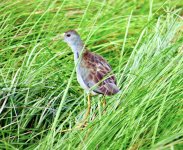Finlay Fraser
Member
I'm new here so please indulge me if I post a question about birds I identified at an earlier time.
I took this photo in the Amazon rainforest in Peru, December 2016, from an oxbow lake next to Rio Tambopata, Madre de Dios region. My guide thought it was a sandpiper, but I believe it is a rare Azure Gallinule. These are not so uncommon further south such as in Argentina I think, but only very occasionally seen in Peru and when they are seen it is in Dec-Jan in the Madre de Dios area (according to my Peruvian bird book), so that all fits.
Opinions very welcome....
I took this photo in the Amazon rainforest in Peru, December 2016, from an oxbow lake next to Rio Tambopata, Madre de Dios region. My guide thought it was a sandpiper, but I believe it is a rare Azure Gallinule. These are not so uncommon further south such as in Argentina I think, but only very occasionally seen in Peru and when they are seen it is in Dec-Jan in the Madre de Dios area (according to my Peruvian bird book), so that all fits.
Opinions very welcome....






